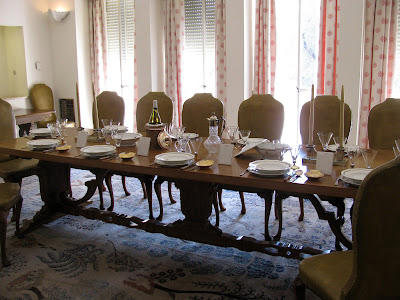The Weizmanns were born in Russia, studied in Germany and Switzerland, and lived for some 30 years in England. They chose to build their home in Israel, in Rehovot, next to the Daniel Sieff Research Institute, which later became the Weizmann Institute of Science, Israel's foremost scientific establishment and think tank.
In 1934 Chaim Weizmann, who was then living in England, asked Mendelsohn to plan his home in Israel. After negotiations which lasted for about a year and much discussion over costs, the Weizmanns took residence in January 1937, and from 1949 - the election of Dr. Weizmann to the Presidency of Israel - until his death three years later, the house functioned as the official residence of the President of Israel. After Weizmann’s death, the presidential residence moved to Jerusalem. Weizmann's Rehovot home was adapted into a museum in 1978 and underwent further renovations in 1999, during the presidency of the Weizmanns' nephew, Ezer Weizmann.
Our tour of the house included the entrance floor (entrance hall, dining room, library, drawing room, and kitchen area) and the upper floors (bedrooms and washrooms). The cloakroom at the front entrance now contains an exhibit on members of the Weizmann family, Dr. Vera Weizmann’s public activity, and the Weizmanns’ son Michael, a pilot killed in World War II. It also displays some of Dr. Chaim Weizmann’s personal belongings including his Israeli passport, numbered ‘00001’. Never has founding a country had so clear an effect on one’s travel papers!
There is no memorial in Israel in the name of Michael Weizmann, the younger son of Chaim and Vera Weizmann, who fought in the Royal Air Force during World War II and his plane was shot down over the Bay of Biscay. Vera planed to build a sanatorium in Michael's name for wounded soldiers on a piece of property the family owned, but when a donor came with an offer to significantly extend the size of project in exchange for naming the sanatorium in his name, she readily agreed, for the sake of soldiers she so much cared about.
After touring the house we stepped outside to visit the grounds and take a close look at the Royal Ford Lincoln Cosmopolitan car, displayed inside a temperature/humidity-controlled glass enclosure. In 1950, Henry Ford II presented Dr. Chaim Weizmann with the car, one in a series of 18 of its type, manufactured according to specifications drawn up for the President. It served as the official car of the President of Israel.
The Weizmann estate includes an expansive garden sprawling over 44 dunams and was also designed by Erich Mendelsohn, who was known as a great lover of nature. The vegetation is varied and includes numerous plants common to the region such as citrus, olives, figs and oaks, as well as tropical plants such as mango and persimmon. In contrast to the house’s straight lines, the garden’s trails are curved. An exception is the straight path leading to the graves of the Weizmanns, paved after the President’s death. Weizmann asked to be buried in the garden of the estate next to his house. At the request of Vera Weizmann, in memory of their son, his tombstone, designed by sculptor Moshe Ziffer, was fashioned after the tombstones of missing soldiers in Great Britain, where their son’s name is engraved. Chiseled in the centre is the emblem of the Weizmann Institute of Science (the Tree of Life). In 1966, fourteen years after Chaim Weizmann’s death, Vera Weizmann was buried by his side.












































4 comments:
Very interesting.
an impressive estate. certainly a family that left a mark on society.
Interesting architecture. I love the spiral staircase and the tall narrow windows. How neat that the first refrigerator in Israel sill exists and you got to see it. It is always neat seeing period things like this and realizing how far things have come in such a short period of time.
So interesting. What a simple yet imposing home
Post a Comment